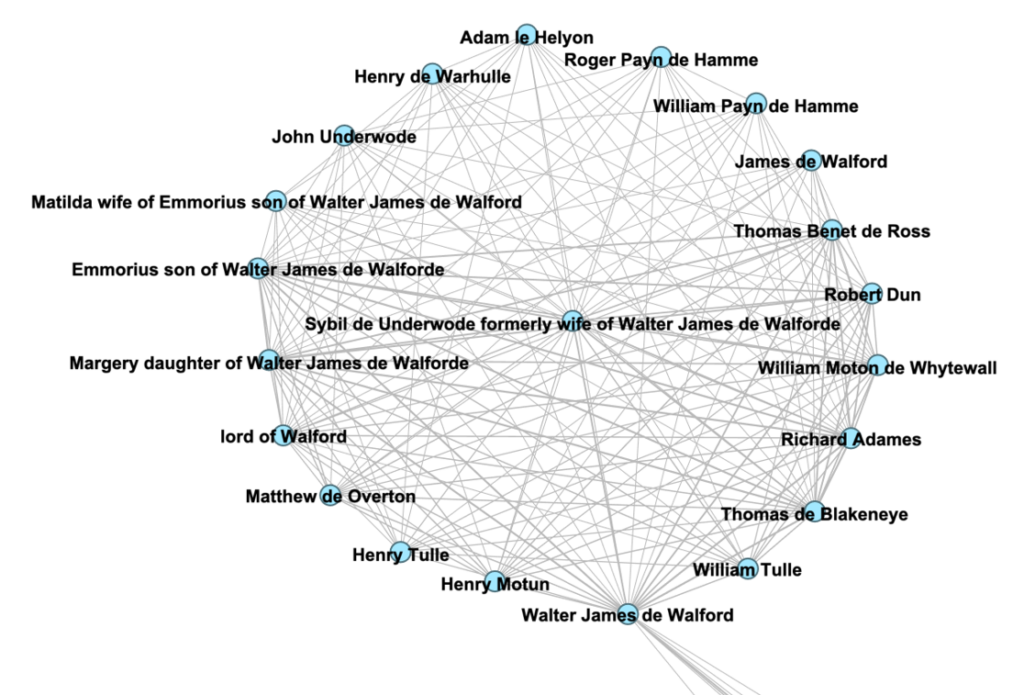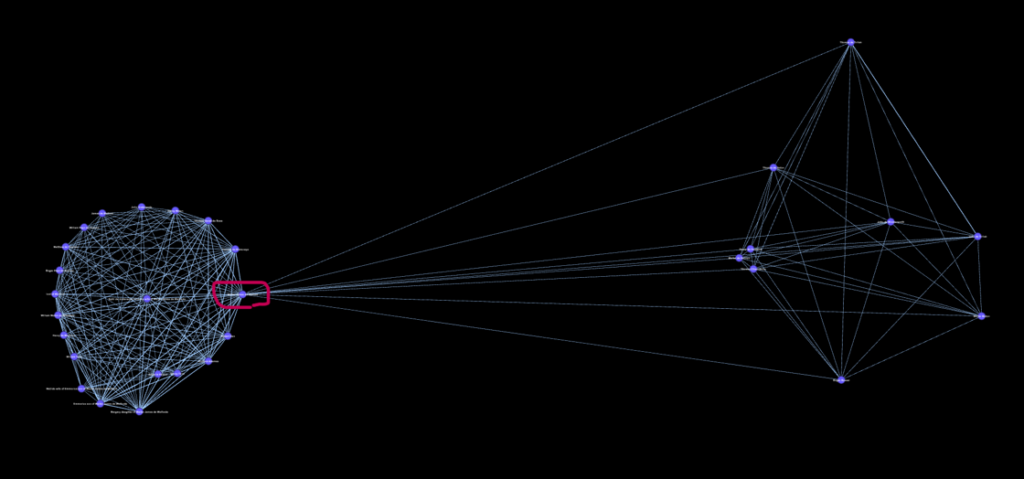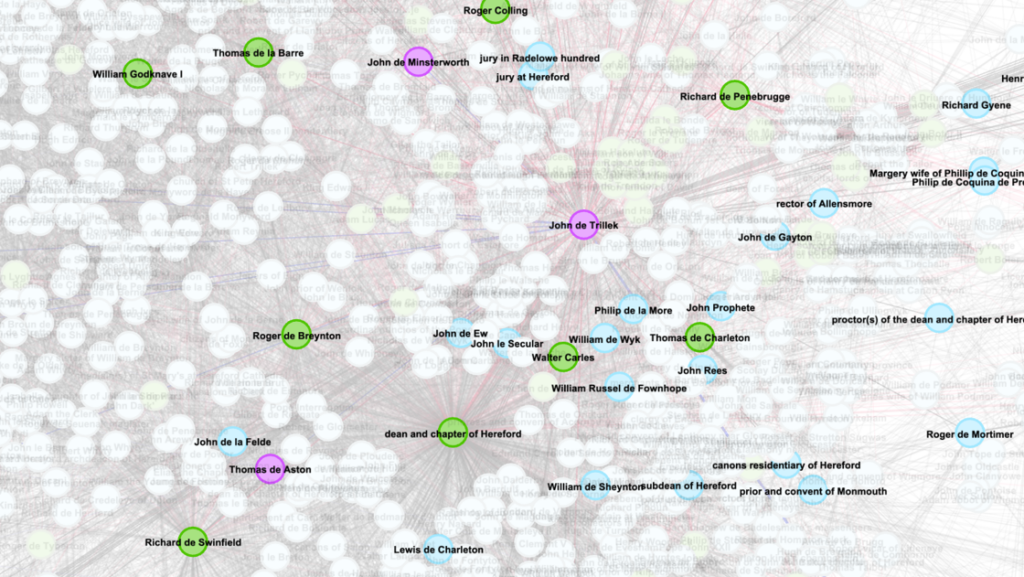When analyzing one person’s location in a network of great size from the data of the Hereford Cathedral Muniments, it is not uncommon for one node to only reach another through multiple degree levels, leaving them barely connected at all save for being recorded as existing in the same network. In the case of Sybil de Undwerode, a widow only mentioned in five muniments, leaving her isolated in the greater scheme of the Hereford Muniments, and Sir Richard de Penebrugge, war hero and previous under chamberlain to King Edward III with ten muniments and farther reaching connections, their two personal biographies could not have been farther apart, but through analysis of their network profiles, I have found a connection between medieval widow and knight. In this blog post, I will be expanding on the vast societal difference between these two persons in terms of gender, class, and presence in the documentation of Hereford Cathedral Muniments through their personal biographies while placing that in the context of their connected network profiles.
Richard de Pennebrugge/Pembridge
Having served King Edward III in the battles of Sluys in 1340 and Poitiers in 1356, Richard de Penebrugge was awarded as one of the first Knights of the Garter[1] and served as a witness in a majority of his Hereford Cathedral Muniments. He married Elizabeth Strange Baroness St. John Basing and had a son, Henry de Penebrugge, although that son did not live past fifteen years old. Richard de Pennebrugge’s estate was inherited by his nephews, specifically Thomas de la Barre, son of his sister, Hwaise[2]. After his death, Richard de Penebrugge was buried at Hereford Cathedral where his tomb is still visible. The helm to his suit of armor is currently on display at the National Museum of Scotland under reference A.1905.489[3]. Through his network and his documents from the HCM, Richard particularly took positions of witness to a majority of royal writs and land disputes; those he was listed with as a witness included family, neighbors, fellows of his social class, even when those fellows are only referred to as ‘knights’. Most of these documents containing exchanges of land might serve in his title of dominus, as referenced in No. 1377, which might refer to his distinction between the grouping of ‘knights’.

Included in the wide-spread of Richard de Penebrugge are King Edward III and Pope John XXII, showing what social circles he was included in on accounts of business. Through his network, we are also able to trace noticeable knights or members of the gentry that function as bailiffs or sheriffs, one of note being Edmund Hakelute, brother to Thomas Hakelute who was chancellor and canon of the Hereford chapter. Richard de Penebrugge’s position socially required him to rub elbows with many of the upper members of Herefordshire’s society, pertaining to clergy members like the dean of the chapter of Hereford and royal in the way of King Edward III. This results in his ego network, as seen above, being less contained and likely to sway the importance of his connections to other nodes. Richard is recorded to be closer to King Edward III than he is with his heir Thomas de la Barre on account of the time frame of the recorded muniments, potentially providing a sense of time in relation to his nephew’s presence in official documents and Richard de Penebrugge’s relinquishing his presence on account of business in order to hand over the position of family head. The clusters present in this network refer to other names listed as witnesses that Richard de Penebrugge was also included in, noticeably the tightest cluster which refers to HCM No. 1277, a land grant of one and a half acres.
Sybil de Underwode
Married to Walter James de Walford and mother of two children, the son Emmorius, husband to Matilda, and the daughter, Margery, Sybil’s presence in the Hereford Cathedral Muniments is isolated to an event recorded after the death of her husband in an event of land release and gain in accordance with the death of her son and potential marriage of her daughter. In the few documents she is present in (HCM No. 600, 602, 605, by name as opposed to family relation), Sybil is only mentioned tangentially in most of them as a reference to the location of said land being disputed between her children, daughter-in-law, and Dominus Thomas Benet de Ross. She does not have a presence outside of these listed muniments nor do a majority of the witnesses to the exchange or also used as a measurement of land, leaving her recorded network a clique on the edge of the greater presence of the mass network. Below is a visual of those included in these muniments, placed to accessibly read the names of said persons mentioned, most of them her neighbors, through Sybil de Underwode’s ego network.

Thomas de Blakeneye and William Moton de Whytewall are owners of land neighboring Sybil’s while others seem to be present for an authoritative purpose, like the lord of Walford witnessing land exchange in Walford and Thomas Benet de Ross acting as chaplains. Emmorius, his wife Matilda, Margery, Walter James de Walford make up Sybil’s immediate family, potentially including John Underwode, if Sybil married him after the death of her first husband. In comparison to the entirety of the Hereford Cathedral Muniments records, this network is small and self-contained which I assumed was because of Sybil’s place as a widow. In relation to other widows recorded in the Hereford Cathedral Muniments, Sybil de Underwode holds an authority that other widows do not. The women in the HCM who are described as widows in the documents are usually found in records related to land release. For example, Agnes, wife of William in the Wough, in No. 2097 is found quitclaiming her right by dower, which would have afforded her, which, in accordance to Paul Brand’s Dower “Ex Assensu and Trial by Jury and Trial by Witnesses in the English Medieval Common Law”, is a widow’s right to claim lands which the husband had never held if they had been in the possession of a close relative of the husband at the time of the marriage provided the relative had been present at the marriage and given consent to the endowment made by his or her heir[4]. A majority of the documented widows, such as Agnes wife of William de la Calewe and Celia wife of Thomas Blud of Hereford, were also found to be releasing lands that their late husbands had authority over. Edith de Warewent released her husbands land to her brother, and Alice, formerly wife of William Fremon of Clehonger possessed a royal writ that allowed her to reclaim the lands given to her husband as part of her dowry, but Sybil appears to have retained a majority of her land, which is always defined using her name alone, not that of her late husband Walter James de Walford, nor of her potential new husband John Underwode, who is only mentioned as a witness to these documents.
Sybil’s uncontested possession of the disputed properties leaves her documented existence self-contained in relation to the rest of the HCM network, only affecting her children and her neighbors. The only person that serves as a connection to the rest of the network is Walter James de Walford, who died at least six years before Sybil’s five documents were recorded. A majority of his presence in the HMC is done posthumously in Sybil de Underwode’s documents in reference to his children’s identities. There is only one document, HMC No. 2456, that connects Walter to the rest of the greater network, enlarging Sybil’s personal network on the second degree to that of Richard de Penebrugge.

It is only through expanding our view of Sybil’s network through the ego network of her husband, Walter James de Walford, that Sybil’s intersects with the rest of the HCM. As seen in the figure three, these nodes are all connected between each other as a result of HCM document No. 2456. No. 2456 was an inspeximus by Bishop Thomas on account of grant between John Trillek, his brother, and Walter James de Walford that was noted at the end of the muiment to be canceled for reasons unknown. It is through this exchange with Bishop Thomas that Richard de Penebrugge’s network is brought into Sybil’s.

When following Walter James de Walford’s ego network, the personal networks of Sybil de Underwode and Richard de Penebrugge connect on the third degree from both sides because of document No. 2456. Through this document, both Sybil and Richard’s networks intersect through the principles and witnesses listed below in which figure three partially displays through John de Trillek’s ego network:
- Walter James de Walford, husband to Sybil de Underwode
- Thomas de Astin, knight
- Walter Montun de Whytewall, Sybil’s neighbor
- Roger Russel, witness
- Henry de Hereford, knight
- Walter de Helioun, witness
- Thomas Chaundeller, witness and scribe
- Thomas de Trillek, dean of the church of St. Albrith
- John de Trillek, bishop of Hereford
- John de Ministerworth, witness
- Edmund Hakute, knight and sheriff
- Knights
This is the only document in which Walter James de Walford is recorded alive, providing not only a reference to his flourishing years, but also when, or if, Sybil herself was remarried to John Underwode. This could also serve as an understanding of what areas deserved the attention of which knights or bailiffs, seeing as Walford is southeast hor Hereford while Pembridge Castle[5] is northwest, potentially explaining Richard’s absence as witness to a land exchange. It is through this single document that the network of a widow and a high-ranking knight are connected, something I only saw when analyzing their personal ego networks. By applying network analysis to these two people, the greater-than-expected weight of Sybil de Underwode is felt in how she is now connected to Richard de Penebrugge without the added details of her variation from the other widows. It is only through one document which we have a record of two different medieval lives connecting.
[1] Britannica, T. Editors of Encyclopaedia. “The Most Noble Order of the Garter.” Encyclopedia Britannica, January 19, 2024. https://www.britannica.com/topic/The-Most-Noble-Order-of-the-Garter.
[2] Sally Badham, “Church Monuments Society,” Hawise de la Barre d. pre 1381, heiress of the Pembrugge family of Clehonger (Herefordshire) – Church Monuments Society, accessed April 5, 2024, https://churchmonumentssociety.org/monument-of-the-month/hawise-de-la-barre-d-1385-heiress-of-the-pembrugge-family-of-clehonger-herefordshire.
[3] Global Arts, Cultures and Design, 2 min read. “Pembridge Helm.” National Museums Scotland. Accessed April 5, 2024.
[4] Paul Brand (2021) Dower Ex Assensu and Trial by Jury and Trial by Witnesses in the English Medieval Common Law, The Journal of Legal History, 42:2, 147-170, DOI: 10.1080/01440365.2021.1946174
[5] “Pembridge Castle: Newland: Penebruge – Fortified Britain.” Fortified Britain – Educate. Inspire. Preserve., February 3, 2021.

